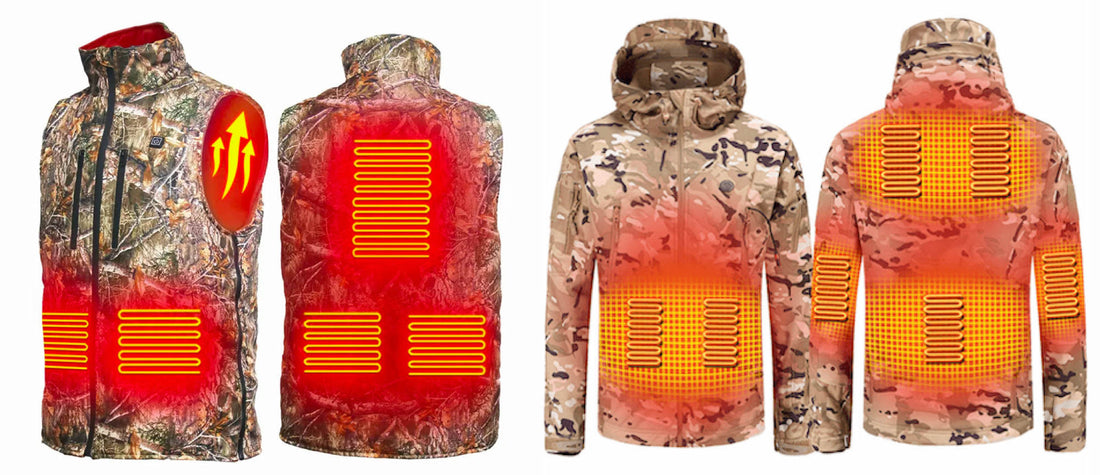When the temperature drops below 10 degrees and you're waiting for hours on your spot, hunting, you don't want to be frozen in place because you didn't layer properly.
But you also don’t want to be stuck with so much layering, sweating like a cornered whitetail, should the temperature be a little warmer. This problem still exists even when making use of heated hunting gear for the top part of the body, especially since little difference is known between the heated hunting jacket and the heated hunting vest.
Let us take a look at the comparison (similarities and differences) between these two apparel to know how to use them properly, the best conditions to wear them, and which is your best option.
What Are The Similarities
The self-heating hunting jackets and their vest relatives have various similarities.
- They have the same operating principle. They make use of heating elements and electrical wires that can be powered by batteries. Additionally, the heat generated can be regulated to an acceptable level.
- They are highly durable (up to 8 hours depending on the battery you use, and even more if you purchase more than 1 battery). Because of the use of damage-proof materials like carbon fiber and graphene in these garments, the heated vest and jacket are both highly impervious to wear and tear.
- They are both waterproof: Nylon and polyester are used to protect the wires from water. Because of the waterproof nature of their materials, both apparels will keep you dry in rain or snow (they can even be machine washed).
- They can be cleaned and maintained in the same way.
It may seem that there is no need to differentiate between a self-heating hunting jacket and its vest counterpart because of these similarities. But there are differences too.
What Are The Distinctions?
The difference between a heated hunting jacket and a heated hunting vest is that, well, one is a jacket and the other is a vest. To list it out, we could say the difference lies in:
- Style: The self-heating vest is sleeveless, while the jacket has sleeves. The vest has a more casual and leisurely look to it that would be ideal for less intensive outdoor activities, while the jacket has a more formal feel to its style.
- Pricing: A heated jacket for hunting would cost more than the vest. This is because it uses more materials and mostly makes use of graphene as its prominent conductor—although some jackets may use carbon fiber. Some vests use graphene as well, but they are very few—and more expensive. Instead, carbon fiber is more common for the vest.
Considerations When Choosing Between a Heated Jacket and a Heated Vest
There are two major factors to consider when choosing between a heated hunting jacket and the vest.
Hunting Layering
Depending on where you are hunting and the state of the weather, you may have different layering styles.
For mild weather conditions (45ºF to 70ºF/ 7º to 21°C), you would need a base layer, a mid-layer, and an outer layer. In cold and frigid conditions (below 45ºF/ 7ºC), your mid-layer would need to be thick, and then you would have to add an additional insulated mid-layer to trap in the heat.
These two garments play similar roles at different stages of hunt gear layering. The heated hunting vest is used in this mid-layer, while the jacket is usually worn as the outer layer.
-
A heated jacket or a heated vest?
When layering, a heated vest will be worn as a mid-layer garment. It can be worn underneath any type of jacket and over any type of base layer. Meanwhile, a heated jacket has to be worn as an outer layer. Keep this in mind when choosing your gear for each layer.
Also, since it’s the outer layer and the thing that potential prey could see, getting a heated jacket for hunting means you would have to shop for one while keeping the patterns in mind. But for the heated vest, that would be irrelevant because they are undergarments. We have black, snow camo & green camo heated hunting vests.
Climate Condition
Having previously mentioned the appropriate way to layer when going out for your hunting trip, we established how the weather condition affects this choice. From hot to mild and cold to frigid, the various weather occasions should be considered when deciding between a heated vest or jacket.
-
A heated jacket or a heated vest?
When you are wearing a heated jacket for hunting or a vest, you don’t need as many layers. This is a good thing and a big advantage because too many layers will restrict your movement.
However, in the case of the heated vest, this can also be a disadvantage. A vest has no sleeves, so when you find yourself in a really frigid situation, it keeps your core warm, but your arms are left with very few layers to protect them from the cold. In that instance, a heated jacket instead of a heated vest would be much more ideal.
If the weather is very cold (under 23ºF / -5ºC), then wearing your heated vest + heated jacket will help you to stay warm while hunting for more hours!
Conclusion
Our heated hunting gears have unique features, strengths, and designs, making them excellent hunting companions in the winter. But they also have their limitations. Knowing when to pick the right apparel can make a massive difference in the success of your hunt each time you step out into the cold, windy atmosphere in search of a worthy quarry.



